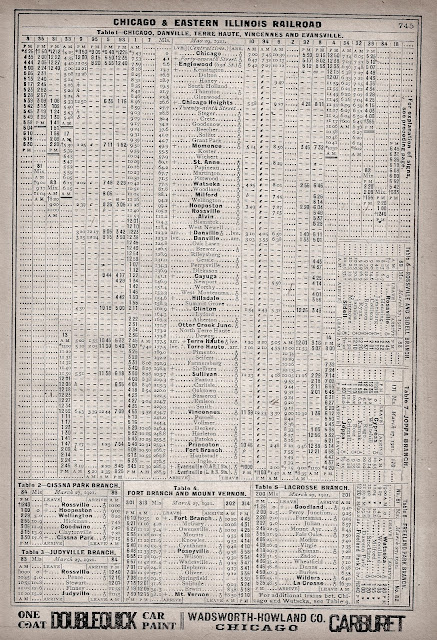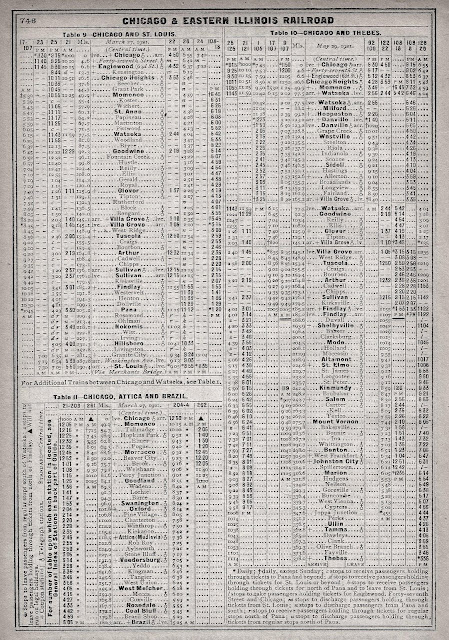Update:
a description of the C&EI and four photo pages by JD "Tuch" Santucci, MPRR Engineer '78-'85 and
another description by T. Greuter.
 |
Bill Molony posted
This company map of the C&EI is dated July 1, 1957.
Ed Schloz: I see my hometown of Pana, Illinois. The C&EI shared a track with the NYC from St Louis to Pana and then went on to Findlay.
David Forbes: Ed Schloz and before that connection from Findlay to Pana was built, the C&EI had trackage rights from Shelbyville to Pana on the NYC.
John Bona: Did the C&EI interchange with the IC? If so, where?
Ed Cooper: The June 1954 OGR gives six interchange points between C&EI and IC: Pana, IL; Perryville, IN; Sullivan, IN; Sullivan, IL; Thebes (Gale), IL; and Tuscola, IL. See page 785.
Christopher Gobert: Pretty sure there was interchange in Marion, Williamson County, also. And perhaps Benton as well.
|
 |
Steven Burns posted
News Paper from April 5, 1966 - full of history
Chicago & Eastern Illinois Railroad Historical Society shared |
 |
http://www.r2parks.net/c&ei.html,
domain name now owned by evilware.
|
I did not even know the Chicago & Eastern Illinois (C&EI) existed until after I started writing this blog.
I learned while studying
Dolton Junction that the C&EI tracks ended there and they used the
C&WI to access
Dearborn Street Station. They also had the 35th Street Yard along the C&WI as their passenger coach yard.
I quickly learned that going South the route split south of Watseka, IL with one route going to Evansville and the other going to St. Louis.
But I did not realize until recently when I stopped in Marion, IL to take pictures of railroads that UP/SP/MoPac/C&EI existed further south than St. Louis. (I saw one of the "call if trouble" signs at a crossing was labeled UP.) Looking at a map when I got back home, I learned there is a branch off the St. Louis route at Findlay, IL that goes south to the tip of the state. From what I have learned about Illinois railroad history, I presume that this branch was built to tap coal mines in southern Illinois. But that is strange in the case of this railroad because there are coal mines to this day working along the eastern branch.
I saw nothing noteworthy enough along the UP to warrant a picture. But I took a lot of pictures of the Crab Orchard and Egyptian Railroad (CO&E). One was this picture of their tracks looking west.
 |
| 20150930 4930 |
By zooming in (below), I can see the north/south UP tracks in the background crossing the east/west CO&E tracks. The blue car is on the connector in the northeast quadrant.
 |
| An excerpt from the track picture. |
The eastern branch was bought by Louisville and Nashville in 1969, which went through the corporate lineage of Family Line System (1972), CSX-Seaboard System (1983), and CSX (1986) (
r2parks). The rest was sold to Missouri Pacific in 1969, which was bought by the UP in 1997. The UP had already merged with SP in 1992 (
r2parks). UP also has the southern segment of C&WI north of Dolton until it meets Metra's ownership of the C&WI at 75th Street. CSX has trackage rights over UP's main stem and both have trackage rights over Metra. UP also got ownership of C&WI's 51st Street Yard in addition to C&EI's 35th Street Yard. The 35th Street Yard was converted to intermodal service, but its use has significantly declined since
Global 4 was built. It looks like it is now a storage yard for unused intermodal cars. It appears the 51st Street yard was bought by Norfolk Southern to expand its 47th Street Yard.
 |
David Daruska posted
I don't know about you, but this color scheme rocks in my opinion. |
 |
Michael North posted
Out along the C&EI |
Richard Stephen
posted five images with the comment: "
Chicago & Eastern Illinois Time Tables from 4/20/1962 - from my collection. The virus lockdown is causing me to find all kinds of things I forgot I had! The system map in this timetable is of particular interest to me."
 |
| 1 |
 |
| 2 |
 |
| 3 |
 |
| 4 |
 |
| 5 |
John Sniffen
posted five images with the comment: "100 years ago, the Chicago & Eastern Illinois in the June 1921 Official Guide of the Railways."
Rick La Fever: It has been said that John W. Barriger III, when he was President of The Monon wanted to merge the Monon Railroad with The Hook & Eye(C&EI) to form a super regional railroad but was rebuffed by many.
JWB felt that these two railroads were a natural fit, like a hand in a glove.
The wrist being Chicago and the fingers the end points of St.Louis, Evansville, Louisville KY and Indianapolis Indiana.
 |
| 1 |
 |
| 2 |
 |
| 3 |
 |
| 4 |
 |
| 5 |
Search
GenealogyTrails for "Chicago & Eastern."
 |
C&EIRHS posted
In 1903 the C&EI was building the Woodland Junction to Villa Grove cutoff. A crew was driving piles for the new bridge and the mule teams were busy building the fill to cross over the NKP Lafayette to Peoria line at a location named Hustle.
Bob Ralph: It was a two track connection to the west from the north on C&EI, lots of livestock moved this way to the stockyards in Chicago, they were red ball connections to avoid having to offload and reload the animals for food and water.
[This page did not allow adding a photo to a comment so I could not contribute the following.]
|
zzz
 |
| 1982 East Lynn Quad @ 24,000 |
Update:
Chicago and Eastern Illinois In Color by Edward M. DeRouin
- p 6: C&EI was the 1877 merger. On Jan 2, 1849 the Evansville & Illinois Railroad was formed to build north to a B&O predecessor at Vincennes, IN. "The intent of the E&I was to rob the Wabash and Erie Canal of its traffic." In 1851, E&I created a subsidiary to build north to Terre Haute and Crawfordsville. The rails reached Princeton by 1852. But in 1853 they reorganized and headed to Chicago instead of Crawfordsville but had the name Evansville & Crawfordsville.
- p 26: The outbound freight house was north of Roosevelt between Clark Street and Dearborn Station with a capacity of 84 cars. Inbound was south of Roosevelt along the leads to the station and could hold 68 cars.
- p 33: 15th Street Tower
- p 34: 16th Street Tower, coach yard is at 51st.
- p 35: towers by Canal Street RR Bridge. "Before picture of Ping Tom Park.
- p 36: Santa Fe passenger engine facilities and Meadow Gold Butter.
- history and p 38: C&EI owned Chicago Heights Terminal and Transfer (CHTT)
- p 39: Canal Street Yard used to be team tracks for perishable products. The 37th Street Yard switched cars for the freight houses of Erie Lackawana, Pennsylvania, ans Soo Line. C&WI mainline ran between these two yards. Crossing and why with Chicago Junction -> Chicago River & Indiana -> NYC at 40th Street. CJ served the stock yards and the Central Manufacturing District. C&EI used the rails of the CJ to reach the stockyards and deliver to the Chicago Produce Terminal.
- p 40: 47th Street Station. Last trains to use the station where commuter trains,which ended August 16, 1964.
- p 41: C&WI mainline passed between 51st Street Coach Yard (NKP passenger coach in picture) and PRR's 55th Street Yard.
- p 47: (1969) MoPac engines under wire. NIPSCO cars used CSS&SB, C&EI, SOU, and 16-mile Algers Winslow & Western Railway to get coal. (1971) MoPac engines pulling coal train through Pullman Junction to Rail to Water Transfer facilities located at 100th Street and the Calumet River.
- p 48: Around 103rd Chicago had a water pumping plant that received coal hoppers several times a week.
- p 51: Picture of the coaling tower and glimpse of roundhouse that is already looking forlorn in 1951 at Yard Center.
- p 52: The north yard builds outbounds, the south yard receives inbound trains and assembles the transfers bound for Clearing, 37th Street Yard, and other Chicago deliveries.
- p 59: Thornton Junction Tower: C&EI vs. GTW. A lot of auto part cars between Michigan and St. Louis were interchanged at this junction. On this and other pages, many of the trains were over 100 cars.
- p 61: (1965) C&EI and CHTT served 68 industries in Chicago Heights. Cars were interchanged with EJ&E, NYC (MC), Milwaukee Road, and B&OCT.
- p 62: C&EI used Wansford Yard on the north side of Evansville. The H yard on the south side was L&N.
- p 64: M.G.(Pence) Tower in Momence. The Milwaukee uses trackage rights on the NYC (Kankakee Belt) for a short distance to cross the C&EI at M.G.. Milwaukee's Joliet Branch extends from Delmar 2.5 miles east of M.G. to its namesake city.
- p 67: Partial picture of brick tower. (p 65 is a picture taken from south window of tower.)
- p 69: two pictures of Kankakee bridge(s).
- p 70: RDC1: 70 mph, passenger trains: 80 mph: freight trains 60 mph between Yard Center and Clinton, IN.
- p 72: Brewer Yard is 3.3 miles south of Danville. Actually, railroad-south, it is actually east of Danville.
- p 73: Rick Schroeder skunked the tower with the NKP "Peoria Division" junction.
- p 74: Experimented with long trains : 177 car, 15,062 ton coal train in 1963. Pioneered in the late 1950s with first unit coal train and coordinated Ohio River-Rail and Lake Michigan-Rail coal rates.
- p 75: had piggyback ramps at 33rd Street as well as Yard Center.
- p 76: Danville freight house. Big grain elevator behind it.
- p 77: Big coaling tower still left next to new diesel servicing facilities in Oaklawn Shops, 1.6 miles south of the Danville passenger station.
- p 80: Baker Yard north of Spring Hill was modernized in the Fifties.
- p 83: Picture of a train on a steel trestle crossing Grasshopper Creek near Buncombe, IL. Between Nielson and West Vienna, CB&Q had trackage rights on C&EI's single track. This gave CB&Q a route to Paducah and a link to Dixie.
- p 85: West Vienna tower hooping orders manually. The operator better lift his arm or the BN firemen will fall out of the engine.
- p 86: At Jappa there is floating rail-to-barge transfer. In 1954 they opened rail to barge coal transfer. In 1958 another opened in Mt. Vernon, IN. Also in 1958, C&EI opened rail to lake using BRC at 100th Street and the Calumet River. Since the St. Lawrence Seaway opened in 1959, C&EI saw lake and metallurgical coal traffic grow in the mid-sixties. A 101-day BRC strick in 1968 killed the rail-to-water business.
- p 87: Mitchell Yard was northeast of St. Louis. A connection with Alton and Southern to the yard was added on Aug. 10, 1926.
- p 88: Connection with TRRA is in Granite City.
- p 89: began Chicago-St. Louis piggyback service in 1949.
- p 90: The Gateway Arch is almost complete on Oct. 8, 1965 as 244 descends off the Merchants Bridge.
- p 91: BL2 201. It looks like a Baldwin, but BL1 was an EMD demonstrator.
- p 121: 1968 photo of two John Deere combines loaded on a 60' flat car. The combines are small enough that a grain header can be shipped in the middle between them.























nice
ReplyDeletecouple of typos, css&sM > css&sb ; c&ej > c&ei
Thanks for noting the typos. They should be fixed.
DeleteThank you for all this. I remember the C&EI from Sullivan, IL.
ReplyDelete